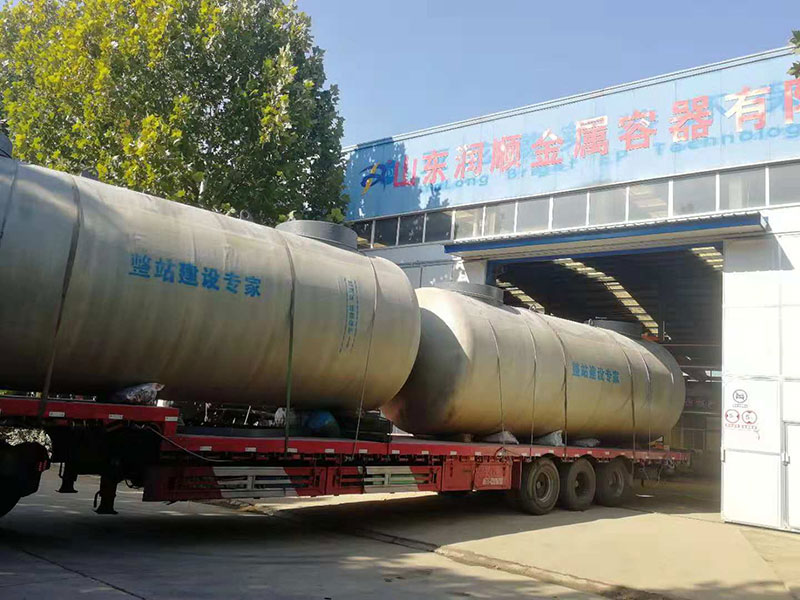
-
Consultation Hotline:
-
Whatsapp:


SF, full name steel-reinforced fiberglass double-layer structure oil storage container, is a double-layer structure oil tank formed by adding a fiberglass-reinforced plastic (FRP) anti-seepage jacket outside a single-layer steel oil tank. There is a through gap space between the steel inner tank and the FRP outer tank.
Double-layer composite structure: composed of a steel inner tank and a fiberglass-reinforced plastic (FRP) outer tank, with a certain gap between the two layers to form an independent monitoring space.
Inner layer: The inner tank is made of steel material, with high strength, suitable for storing oil products; the outer tank is made of FRP material, which is corrosion-resistant, anti-aging, and adapts to complex environments.
Outer layer: The reinforced fiberglass layer has a thickness of more than 4mm, with good compressive and seismic resistance, and has corrosion resistance and electrocorrosion resistance.
Gap monitoring design: The double-layer gap can be filled with inert gas or a monitoring system can be set up. The leakage detector monitors in real time 24 hours a day, and alarms when the liquid level at the bottom of the gap space is detected, improving safety.
Material characteristic combination: The inner tank is made of steel material, with high strength, suitable for storing oil products; the outer tank is made of FRP material, which is corrosion-resistant, anti-aging, and adapts to complex environments.
Overall sealing: The joints, welds and other parts of the tank body are specially treated to ensure the sealing of the double-layer structure and reduce the risk of leakage.
Structural compactness: The integrated design has a volume similar to that of a traditional single tank, saving installation space and facilitating transportation and on-site construction.
If the inner tank of the double-layer oil tank leaks, the gas or detection liquid with a certain pressure in the double-layer gap will enter the atmospheric pressure inner tank; the pressure or liquid level in the double-layer gap will change, triggering the sound and light alarm. After the stored liquid leaks into the double-layer gap, since the outer tank is intact, the stored liquid will not leak out. Therefore, the stored liquid, soil and groundwater are all safe.
If the outer tank leaks, the gas or detection liquid with a certain pressure in the double-layer gap will enter the soil. Similarly, the pressure or liquid level in the double-layer gap will change, triggering the sound and light alarm. At this time, since the inner tank is intact, the stored liquid is safe; only gas or detection liquid enters the soil, so the soil and groundwater are also safe.
Because the stored liquid in contact with the inner tank and the soil and groundwater in contact with the outer tank are different media, and the corrosion rates of the tank materials are different, the probability of leakage at the same time is almost zero. Therefore, it can prevent the stored liquid from leaking out of the tank, and achieve production safety and environmental protection.
SF double-layer oil tanks are convenient to install, which greatly shortens the construction period and reduces cost investment; the remote monitoring system is convenient for daily and regular detection, digital control, and eliminates complicated manual operations; the protection demand of SF double-layer oil tanks is 1/10 of that of ordinary oil tanks, which greatly saves the maintenance investment cost; SF double-layer oil tanks have high economic efficiency, high environmental protection performance, and can effectively protect energy, avoiding the serious harm and loss caused by energy leakage.
The price advantage of SF double-layer oil tanks has also promoted their popularization and application. Compared with SF double-layer oil tanks, FF double-layer oil tanks are too expensive. For example, in the Japanese underground storage tank market, steel single-walled oil tanks only account for 5%, while SF double-layer oil tanks account for as much as 75%, and FF double-layer oil tanks only account for 5%. Obviously, this is because FF double-layer oil tanks are too expensive. At the same time, SS double-layer oil tanks cannot solve the problem of outer layer electrochemical corrosion, have a short service life, and cannot meet the requirements of energy conservation and environmental protection. Therefore, SF double-layer oil tanks will occupy the market leading position in the future for a long time.
Steel shell welding → flange accessory installation → shell leak test → outer surface sandblasting and rust removal → bottom layer anti-rust spraying → isolation membrane treatment → overall FRP spraying of the shell → curing → FRP treatment of special parts → curing → film thickness space formation inspection → gap pressure and decompression inspection → qualified → warehousing